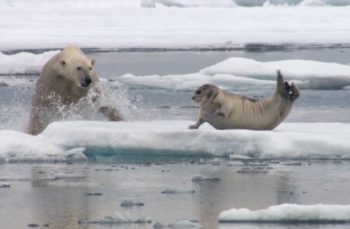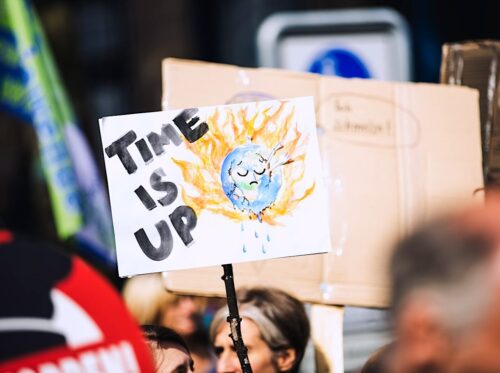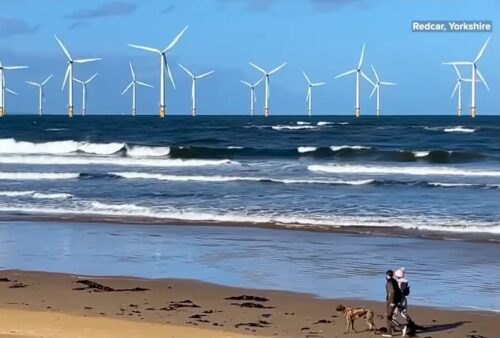
It is not rare to see reports about the paper’s falling readership, cuts to the paper’s newsroom and editorial staff, or factual errors or outright false stories appearing in the paper. (Some of these errors never get corrected. See, for example, its error-filled coverage of the 2006 Duke Lacrosse scandal.)
Of all the Times’ numerous errors, perhaps none have been as consistently egregious as its coverage of climate change. Among major newspapers, the Times has long banged the climate alarmist drum the loudest, unquestioningly reporting the latest environmental lobbyists’ apocalyptic proclamations as if they were gospel truth.
Most recently, the Times hyped a BioScience paper on the impending doom of polar bears, which the paper alleged is the result of human-caused climate change.
The Times couldn’t be bothered to accurately describe the dispute in its headline. According to the Times, the argument is between “scientists” and “denialists” — an ad hominem slur aimed at researchers who dispute any portion of the claim “scientists agree we know with certainty humans are causing climate change and it is dangerous.”
Both sides in the debate have engaged in research on polar bears and anthropogenic climate change, so why call one side denialists? It can only be to instigate a smear campaign, by associating them with truly heinous Holocaust deniers in the public’s mind.
Concerning the BioScience paper, it doesn’t actually examine the effects of climate change on polar bears; it presents mostly opinions and few actual facts.
For instance, the authors amazingly provide no real data on polar bear populations or population trends, although it does cite the number of blogs and research papers discussing polar bears.
This is an exercise in sophistry, not science.
Instead of presenting proof of the fate of polar bears, the authors commit the Fallacy of Appeal to Authority and the Fallacy of Appeal to Numbers to support their assertion human-caused climate change threatens polar bears’ continued existence.
“Increasing surface temperatures, Arctic sea-ice loss, and other evidence of anthropogenic global warming (AGW) are acknowledged by every major scientific organization in the world,” say the BioScience authors, who later tout the existence of “a broad scientific consensus.”
Evidence and proof are the hallmarks of science, and if one claims humans are harming polar bears, one must provide supporting evidence. Scientifically, it is illegitimate to say, “X, Y, Z, and others are experts on climate, and they say humans are harming polar bears, so you should believe us when we tell you polar bears are in danger and other people are lying about it.”
Further, the paper commits numerous logical fallacies any first-year philosophy student would catch. Much of the paper attacks polar bear researcher Susan Crockford, a zoologist with the University of Victoria in British Columbia, Canada. When the authors aren’t simply misleading about Crockford’s qualifications and research, they are resorting to personal attacks.
Crockford has a Ph.D. in zoology. Her dissertation addressed polar bear evolution. She has published numerous peer-reviewed articles and books on Arctic trends and polar bears, and her work has been cited by other polar bear researchers in scientific journals.
She also runs a website called Polar Bear Science, which is aimed at educating the general public on polar bears. The website provides data on polar bear population trends as a species and on specific subpopulations. Crockford openly admits she has completed no original on-the-ground research on polar bear numbers.
However, her surveys of the literature all reference hard data on polar bear statistics. None of the figures she cites on polar bear populations has ever been refuted in peer-reviewed literature, nor were they even addressed in the BioScience paper.
To do so would have meant admitting Crockford uses peer-reviewed data and required the BioScience authors either to show her numbers are wrong or to provide alternate polar bear population estimates.
Whatever shortcomings Crockford may have as a researcher, her qualifications and research methods — including providing data publicly available for outside analysis, comparison, testing, confirmation, or disconfirmation — are not among them. This is something that cannot be said for some of the BioScience paper authors.
Concerning qualifications, one of the authors involved works for an advocacy group. Another, as far as I can determine, works in software quality assurance. A third works in experimental psychology.
A couple of others are atmospheric physicists or chemists. If some of these co-authors produced original, peer-reviewed research on polar bear biology or populations before their names were attached to this BioScience screed, I have been unable to find it.
Several scientists have asserted polar bear populations should decline if summer sea ice falls sharply. This group includes biologist Steven Amstrup, one of the co-authors of the BioScience paper.
However, research reveals when summer sea ice levels plummeted in the Arctic after 2006, polar bear counts showed most subpopulations have been stable or have grown modestly.
A 2007 study by Christine Hunter and other researchers said if summer sea ice levels dropped by as much as they did after 2006 “for eight out of ten years (or four out of five years),” which climate model projections suggested might occur by 2050, 10 of the 19 vulnerable polar bear populations would be extirpated, leaving fewer than 10,000 of the animals worldwide.
Despite sea ice hitting the danger levels feared by Hunter’s team 44 years sooner than projected, just the opposite has occurred.
Unlike the BioScience article, the New York Times, to its credit, did provide at least a modest reference to polar bear trends, asserting, without attribution, “Of the 19 polar bear subpopulations in the Arctic Circle, three have shown substantial declines, including bears in the South Beaufort Sea off Alaska’s coast and in the West Hudson Bay in Canada. One subpopulation has increased in numbers.”
The Times claimed data for nine other populations is too sparse to estimate. One might ask what about the other six subpopulations? While it’s hard to question the Times since it doesn’t say where it got its numbers, a recent survey of the literature by Crockford (published by the Global Warming Policy Foundation) examining each of the subpopulations in detail tells a different story.
Crockford — whose survey relies on peer-reviewed, publicly available data — notes only one subpopulation of bears has declined and two others may or may not have declined. (It’s hard to tell because the purported decline is so small that it’s within the margin of error. Further, the reduced count could be because of the survey methods used.)
Crockford also reported the data are sparse for several populations in Russia. Most importantly, Crockford says the data show existing numbers for the remaining 16 populations are either stable or modestly growing.
In 2005, the U.S. Geological Survey estimated there were approximately 24,500 polar bears in the world before sea ice levels dropped by nearly 40 percent after 2006.
Despite the sea ice decline, in 2015, the Polar Bear Specialist Group of the International Union for the Conservation of Nature estimated the polar bear population was approximately 26,000.
A second survey estimates as many as 28,500 polar bears roam the Arctic. Since polar bears were first protected by international treaty in 1973, this is the highest population count ever recorded.
Crockford provides an explanation for why she believes polar bear numbers have not declined along with sea ice. She notes ringed and bearded seals (the primary prey of polar bears) north of the Bering Strait have thrived in longer summer seasons because their access to fish has improved.
“More food for seals in summer means more fat seal pups for polar bears to eat the following spring.… [A]s long as polar bears have lots of baby seals to eat in spring, they get fat enough to survive even a longer-than-usual summer fast,” Crockford wrote.
In addition, Crockford notes there is limited evidence polar bear weights have fallen significantly, or that the percentage of deaths from starvation has increased.
The fact that BioScience published this report, even after Crockford and others had pointed out the numerous errors it contained when the journal posted a preview version of it in November 2017, exposes how weak the peer-review system for science journals is today regarding alarmist climate claims.
In a tweet about the BioScience paper, noted climate scientist Judith Curry tweeted, “This is absolutely the stupidest paper I have ever seen published.” Curry is correct. Contra the New York Times, there is no “news” in this report, and it was not fit to print.
Read more at The Spectator



















The NYT ‘s is absolutely screwed now that Washington leaking is
in free fall . I’m sure most people there are hard working and honorable but the culture and bias that radiates threw it’ s owners /editors leanings is doing the brand immense damage .
WHY DO POLAR BEARS CRY sounds like the title of some stupid movie just like those crappy movies about the Rain Forests like Fern Gully,Where the River Runs Black Etc or crappy Save the Trees movies like Forest Warrior,Family Tree Princess Molanock Etc